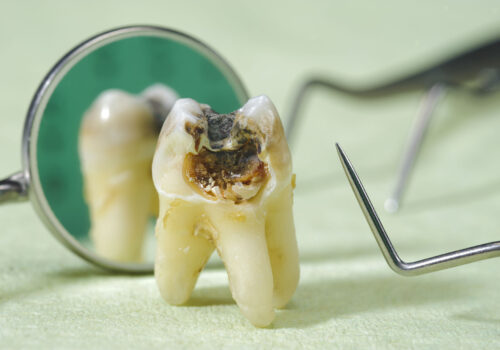
Mercury amalgam fillings usually last 10-15 years. Once they start to show signs of failing, silver fillings need to be replaced.
Because some mercury vapour is released during amalgam filling removal, dentists should take special precautions to protect themselves and the patient from the risk of mercury exposure.
For the most secure mercury tooth filling removal, find a dentist who uses SMART (Safe Mercury Amalgam Removal Technique), a protocol recommended by the International Academy of Oral Medicine & Toxicology (IAOMT).
Safety measures utilised in this technique include:
- Using a filtration system in the room
- Giving the patient an adsorbent solution (often containing charcoal) to rinse and swallow before the procedure
- Fitting a nasal mask to the patient so they have a clean air supply
- Using a dental dam to seal off the tooth being treated
- Using a high-speed saliva evacuator (suction tool)
- Keeping the filling cool during removal
- Removing the amalgam in as large chunks as possible
- Disposing of the old filling material in a safe way
- Using specialist filters in the suction system so waste and mercury do not mix
Dental staff will also use special equipment to protect themselves from exposure to mercury vapour. In the video below you can see how this looks in practice:
In reality, not many dentists in the UK use this exact protocol – and those that do charge accordingly. Before getting amalgam fillings removed, ask your dentist what technique they use and what special safety measures they have in place during the process.
If you feel that they take inadequate precautions, you can always look elsewhere for a clinic that specialises in this procedure.
You might also consider visiting a dentist overseas to save money on filling removal – particularly if you have several teeth that need work. That said, some dentists recommend treating one tooth at a time, with several months between treatments, to minimise the side effects of any mercury that is released during the process.
What does replacing silver fillings with white cost?
The cost to remove amalgam fillings depends on an important distinction:
If it’s your choice to have your silver fillings removed, none of the treatment will be covered on the NHS (even if you have your dentist’s full support). The cost of safe amalgam filling removal with a dentist who specialises in this procedure (using the SMART process described above) can be as much as £200-£300 per tooth – plus the cost of the filling.
Dentists who don’t have quite such extensive safety precautions in place might charge considerably less.
If there is a clinical need to remove your old fillings, this part of the process may be covered on the NHS. If you originally got your amalgam fillings on the NHS, chances are you’ll only be offered amalgam as a replacement on the NHS.
The exception would be if you have had an allergic reaction or if you now fall into one of the exempt groups mentioned earlier.
If you choose to replace your amalgam fillings with composite instead, you’ll have to pay for the white fillings privately. The cost of a single white filling in the UK can be anywhere from £40 to £250 or more, depending on the size of the cavity and other factors.
Composite fillings look good but usually cost more
Some dental insurance policies may cover part of the cost associated with this procedure. You’ll need to check your policy for details though. Base-level policies generally have no allowance for elective cosmetic treatment.
There are many factors to consider when deciding whether to get silver or white fillings.
Dentists worldwide are gradually moving away from using dental amalgam, but this is largely because of environmental concerns about mercury toxicity. Regardless of any health concerns, many people wish to avoid metal fillings because of their aesthetics.
Composite fillings are far less noticeable but aren’t as strong and durable as amalgam, especially in stress-bearing positions. Composite also costs more than amalgam.
Replacing silver fillings with white for purely cosmetic reasons is generally not advised, due to the risk of exposure to mercury vapour and possible complications. However, many dentists do offer this procedure and take steps to ensure it’s done as safely as possible.
If you need a new filling and would prefer not to have amalgam, speak to your dentist about the other possibilities. If a composite filling won’t do the job well enough, a porcelain inlay may work instead.







Leave a Reply